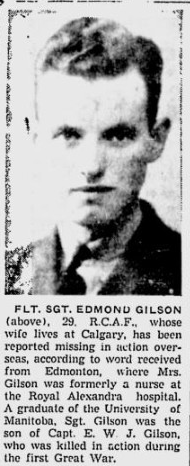Gilson, Edmond William John
Personal Information
| Rank | WO2 |
| Forename(s) | Edmond William John |
| Surname | Gilson |
| Gender | M |
| Age | 29 |
| Date of Death | 28-08-1942 |
| Next of Kin | Son of English born parents Captain William Gilson and Sophia Gilson of Calgary, Alberta, Canada. |
Aircraft Information
| Aircraft | Short Stirling I |
| Serial Number | R9153 |
| Markings | LS-U |
Memorial Information
| Burial/Memorial Country | France |
| Burial/Memorial Place | Mesmont Churchyard |
| Grave Reference | Coll. grave 12. |
| Epitaph |
IBCC Memorial Information
| Phase | 2 |
| Panel Number | 170 |
Enlistment Information
| Service Number | R/76533 |
| Service | Royal Canadian Air Force |
| Group | 3 |
| Squadron | 15 (XV) |
| Squadron Motto | Aim Sure |
| Trade | Observer |
| Country of Origin | Canada |
Miscellaneous Information
| Born 21 November 1912 in Edmonton, Alberta. |
| His Father, of the 1st Battalion, Canadian Infantry, was killed in action 6 November 1917. |
Commonwealth War Graves Commission
The National Archives
| Record of Events (Operational Record Book) AIR 27/203/40 |
| Summary of Events (Operational Record Book) AIR 27/203/39 |
Fellow Servicemen
Please note that this list gives all the losses aboard the quoted aircraft and occasionally these may have occurred on an earlier date when the aircraft was not itself lost. Please check the dates of death carefully.
Last Operation Information
| Start Date | 28-08-1942 |
| End Date | 29-08-1942 |
| Takeoff Station | Bourn |
| Day/Night Raid | Night (90% moon) |
| Operation | Nuremburg. 159 aircraft despatched- incurred 23 (14.5%) losses. Low altitude attack. PFF used target indicators for the first time and were able to place them with great accuracy. Much damage in the Altstadt and the Nazi rally area in the south of the city |
| Reason for Loss | Crashed at Mesmont, near Rethel, France |
